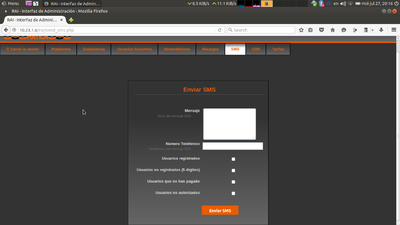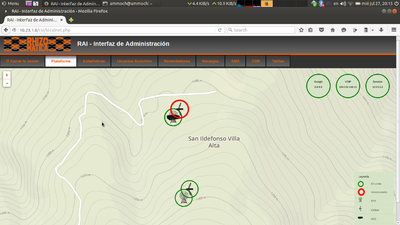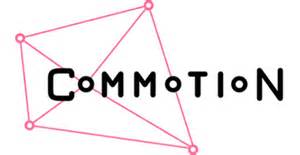Mobiles: Alternatives
From Gender and Tech Resources
Contents
Autonomous and Community Mobile Telephony
According to the International Telecommunication Union[2] in the world there are between 2 to 3 billion people who lack mobile telephony services, this is due mainly because telecommunications regulatory bodies grant concessions to access the mobile radio spectrum only to large companies, restricting access to micro enterprises that wish to provide this service to rural areas for instance.
It is common to think that the only way to communicate through mobile phones is to use the services of large transnational mobile phone companies and that profit is the only economic model for the creation and sustainability of these services. However, there are communities and villages that are located in geographically remote territories, with a low population density and / or where the economy is based on self-subsistence economies, and which remain unappealing for large companies which are in general not interested in providing services (considering for example that the initial investment Is too high). Sometimes, these communities do not want telephony services based on an unscrupulous profit model neither.
It is within these communities that the hope is born for new creative and collaborative ways of providing telephony services. We present below some of these alternative mobile phone projects whose models are based on the exercise of the right of peoples' to communication.
Rhizomatica
The Rhizomatica organization is located in Oaxaca[3], in the south-east of Mexico. It works by creating bridges between communities of indigenous peoples of Mexico and people engaged in telecommunications engineering with open systems, with the objective of creating mobile telephony infrastructure to strengthen the autonomy of indigenous peoples. In order to understand the origin and success of the autonomous mobile telephony project, it is important to understand its context.
Context and history
Oaxaca is a complex territory, with a great cultural diversity (17 indigenous peoples co-inhabit the territory), with a rugged geography, where the territory is communal, there are strong structures of local government recognized by the Mexican constitution and international treaties, Economy is basically based on self-subsistence.
In the 1970s and 1980s, these peoples began their first communal enterprises for the management of common goods * forestry and aquifers that are the precedent for the current communal telecommunication enterprises described here. This complex context is the fertile ground for infrastructure projects in telecommunications that strengthen the autonomy of indigenous peoples.
From the 2006 social movement[4] the native peoples of Oaxaca engaged in the task of creating their own means of communication, with special emphasis on the Community radios. At the moment, Oaxaca is the state with the greater concentration of these radios in all the country. Although there is no official census, social organizations estimate that there are between 60 and 100 community radios currently operating in the state of Oaxaca.
Driven by the need for communication, the communal authorities of these towns approached innumerable times big companies to request services of mobile telephony but the result was a refusal because they are small towns, located in remote areas and with few resources. Because of this, communal villages began a dialogue with the team of Rhizomatica to look for the ways to construct infrastructure of mobile telephony that would strengthen the autonomy of their towns. This was how the Autonomous and Community Cellular Telephone project emerged.
Infrastructure
In technical terms, the autonomous mobile telephony infrastructure consists of a[5] transceiver that emits and receives radio waves at the frequency of 850 MHz with 5 Watts of Power and an antenna located in the high part of the territory which allows to cover up to 15 km around. These are radio waves that require line of sight, meaning that mountainous geography should be considered so that the signal reaches far. Any type of phone can access these networks, a specific SIM card is not required. In the case of Oaxaca, the numbering system is constructed according to the postal code assigned to that territory. The system of administration and billing is made to be adapted to the original languages that are spoken in the locality.
For more details about the architecture system, the hardware and software used, we recommend you to view the Rhizomatica wiki
http://wiki.rhizomatica.org/index.php/System_Architecture/es


Currently (July 2016) the project encompasses 17 communities[6], and some of them are interconnected. Each transceiver is owned by the communal governing body of each village. The cost per telephone registered in the network is 40 Mexican pesos per month equivalent to $ 2 USD for unlimited calls and text messages within the interconnected community or region. For out-of-town calls such as the city of Oaxaca or a city in the United States, calls come through the voice over IP (VoIP) system[7] offering network users the lowest rates in the market. To achieve this it is important that the community that wants to have an autonomous mobile telephone system, first resolve the issue of their Internet connection. Usually this is done through local micro-enterprises that are creating networks through WiFi links to take the Internet to those places. The cost of a computer, the importation of the equipment, the installation and training for its administration is approximately $ 7,000 USD. Currently Rhizomatica uses NuRAN Wireless [8]equipment among other providers. This cost is expected to decline in the coming years with the development of new open source hardware devices.
Among the main requirements for the installation of an autonomous mobile telephone networks we find: - Count with the approval of the community assembly - No signal from another mobile phone company - Have an Internet connection
Rhizomatica currently has around 3,000 users of autonomous mobile telephony services in Oaxaca. From this experience, a group of young computer students developed has replicated a similar project on the Nicaraguan Atlantic coast called SayCel Cite error: Closing </ref> missing for <ref> tag en Argentina[9], su trabajo consiste en crear infraestructura de Internet a través del uso de Software Libre y hardware de muy bajo costo. Altermundi crea redes inalámbricas descentralizadas, mediante routers WiFi y un firmware[10] que permite modificar el funcionamiento del router.
"Una red comunitaria es una red construida, gestionada, administrada, por las personas que la van a utilizar. Priorizan el tráfico local, mantienen acuerdos de peering[11] (tránsito libre) con cualquier red que ofrezca reciprocidad. Así era Internet cuando empezó, ese era el espíritu original, que se ha ido perdiendo. Internet se ha ido cerrando y las redes grandes no dan peering a las chicas, ahí se rompió el modelo de peer to peer[12]. Para nosotros, militar las redes comunitarias tiene dos ejes: dar soluciones concretas a personas de carne y hueso, y a la vez “contaminar” un pedazo de Internet con el viejo espíritu de Internet" Nicolás Echániz[13] miembro fundador de Altermundi.
La principal ventaja de estas redes es que permiten el acceso a Internet en poblados donde no hay acceso a los servicios de compañías comerciales pero sobre todo que son muy sencillas de gestionar y administrar por personas de la propia comunidad, sin necesidad de conocimientos especializados en electrónica o informática y a un precio accesible. Además cualquier persona puede extender la red, respetando su diseño y sus principios porque no se trata de un modelo comercial de crecimiento.
A través de esta red de Internet libre las personas tienen acceso a un servicio de chat local, a la transmisión en línea de la radio comunitaria local, a hacer llamadas VoIP, compartir archivos entre pares y jugar. En Argentina, estas redes se encuentran en Delta de Tigre en Buenos Aires y el Valle de Paravachasca en Córdoba.
Infraestructura
El hardware[14] esta compuesto por un router y una antena, así como otros materiales para adaptar el router y el cable que conecta a la antena en la intemperie. En el router si instala un firmware (sistema operativo) que permite la autoconfiguración y otros programas para la personalización y el monitoreo de la red.
Altermundi modifica los routers para que al conectar con una antena direccional la señal de WiFi pueda cubrir algunos kilómetros, de esta manera se va construyendo una red de dispositivos con señal WiFi por la cual pueden intercambiar datos entre personas dentro de un poblado o región y también pueden conectar la red a lo que hoy conocemos por Internet, permitiendo compartirlo dentro de la red.
'¿Cuál es la diferencia entre Red Libre y red Comunitaria?' Características de una Red Libre:
- libre uso: puede ser utilizada por sus participantes para ofrecer y recibir cualquier tipo de servicio que no afecte su buen funcionamiento
- neutralidad: no inspecciona ni modifica los flujos de datos dentro de la red más allá de lo necesario para su operación
- libre interconexión: permite, de forma libre y gratuita, el flujo de datos con otras redes que respeten las mismas condiciones
- libre tránsito: provee a otras redes libres acceso a las redes con las que mantiene acuerdos voluntarios de libre interconexión.
El objetivo de las redes libres, es devolver el sentido común a la estructura de Internet, permitiendo la libre circulación de la información, aprovechando al máximo la infraestructura y disminuyendo los costos para que las pequeñas empresas puedan desplegarse con facilidad en zonas donde los costos de acceso a Internet son inviables. En este sentido es que las Redes Comunitarias son una expresión de las Redes Libres porque juegan un rol fundamental para la comunidad a través de las siguientes características:
- propiedad colectiva: su infraestructura es propiedad de la comunidad que la despliega;
- gestión social: la red es gestionada por la misma comunidad;
- diseño accesible: la información sobre cómo funciona la red y sus componentes es pública y accesible;
- participación abierta: cualquiera puede extender la red, respetando su diseño y sus principios.
Logros Políticos
Al mismo tiempo que implementaba la tecnología, Altermundi participó del debate a la Ley Argentina Digital aprobada en diciembre de 2014, logrando de forma conjunta con otros sectores que se incluyera en el artículo 94 de la ley el "fomento y resguardo de las redes comunitarias".
Por otra parte, a partir del trabajo de Altermundi con la creación de estas redes libres y comunitarias, se fue conformando un equipo de cooperación que hoy desarrollan Libre-Mesh[15]
Desafíos
El principal desafío que tienen estas redes libres es el tener acceso a un ancho de banda a precio mayorista para conectarse al resto de Internet. Mientras en Europa 1 megabytes por segundo cuestan al rededor de $0.78 dólares al mes, en Argentina 1 megabyte por segundo cuesta $40 dólares mensuales, es decir, 51 veces más que en Europa.
Otros proyectos alternativos
Guifi
Es una red de telecomunicaciones como un bien común. En la actualidad tiene más de 30,000 nodos activos dentro de la red.
"Guifi·net es una red de de telecomunicaciones en la que particulares, organizaciones, empresas y todo tipo de entidades participan promoviendo e invirtiendo en una infraestructura de comunes que les proporciona un acceso a las telecomunicaciones y a Internet de calidad y a un precio justo"[16].
Red Abierta, Libre y Neutral, la cual se define así porque:
- Es abierta porque se ofrece de forma universal a la participación de todos sin ningún tipo de exclusión o discriminación y porque se informa en todo momento acerca de cómo funciona la red y sus componentes, lo que permite que cualquiera pueda mejorarla.
- Es libre porque todos pueden hacer lo que quieran y disfrutar de las libertades tal y como se prevén en la referencia de los principios generales (apartado I.), todo esto independientemente de su nivel de participación en la red y sin imponer términos y condiciones que contradigan este acuerdo de forma unilateral.
- Es neutral porque la red es independiente de los contenidos, no los condiciona y, así, pueden circular libremente; los usuarios pueden acceder y producir contenidos independientemente de sus posibilidades financieras o condiciones sociales. Cuando se incorporan contenidos a la red en guifi.net se hace con el fin de estimular su aparición, gestionar mejor la red o simplemente como ejercicio de incorporar contenidos, pero en ningún caso con el objetivo de sustituir o bloquear otros contenidos.
El Procomún de la RALN (Red Abierta, Lirbre y Neutral) se fundamenta en las siguientes bases:
- Eres libre de utilizar la red para cualquier propósito mientras no perjudiques el funcionamiento de la propia red, la libertad de otros usuarios, y respetes las condiciones de los contenidos y servicios que circulan libremente.
- Eres libre de conocer como es la red, sus componentes y su funcionamiento, también puedes difundir su espíritu y funcionamiento libremente.
- Eres libre para incorporar servicios y contenidos a la red con las condiciones que quieras.
- Eres libre de Incorporarte a la red y ayudar a extender estas libertades y condiciones.
Mapa de nodos: https://guifi.net/es/node/17711/view/map
Videos http://guifitv.guifi.net/?q=node/31 http://media.guifi.net/
Participa! El nodo es tuyo pero la red es de todas las personas que se conectan. https://guifi.net/es/participa
Routers y firmwares que puedes ocupar para participar en la red https://guifi.net/es/firmware
Unirse a guifi.net, en tres pasos[17]
- Añadir un nodo
- Añadir un router nuevo
- Añadir un enlace
Proyecto Serval
Este proyecto, surge de un grupo depersonas en Australia que desarrollan tecnología de código abierto y software libre para crear conexión directa entre teléfonos móviles, a través, de las interfaces WiFI de los teléfonos.
Para utilizar esta tecnología es necesario acceder como usuario root[18] al telefóno móvil para luego poder instalar un software libre desarrollado por Proyecto Serval que permite configurar la antena WiFi en tipo Ad-hoc y crear un Mesh Network[19].
No se necesita una infraestructura WiFi externa al teléfono móvil, simplemente se necesita activar el WiFi de los teléfonos móviles que están cerca y de ésta manera podrán intercambiar datos a través de llamadas, mensajes, fotos, etc. Estos datos viajan de un teléfono a otro, a través, del camino que encuentra dentro de la red de teléfonos conectados. No se requiere de los servicios de una compañía de telefonía móvil. Esta tecnología permite realizar llamadas de voz. Los mensajes de texto y otros datos son comunicados a través del almacenamiento y la retransmisión, sistema que se conoce como rizoma.
Wiki del proyecto Serval: http://developer.servalproject.org/dokuwiki/doku.php
Commotion Wireless
Proyecto desarrollado por Open Technology Institute[20] que consiste en crear redes malla (en ingles llamada Mesh Network)[21] de señales inalambricas[22] con tecnología de codigo abierto[23]. Este proyecto ha utilizado la tecnología Mobile ad-hoc network[24], es decir, una red de nodos móviles conectados a través de señal inalámbrica.
Referencias
- ↑ Fotográfo: Daniel Guzman. Isla Negra, Chile.
- ↑ https://en.wikipedia.org/wiki/International_Telecommunication_Union
- ↑ https://es.wikipedia.org/wiki/Oaxaca
- ↑ https://es.wikipedia.org/wiki/Asamblea_Popular_de_los_Pueblos_de_Oaxaca
- ↑ https://en.wikipedia.org/wiki/Transceiver
- ↑ http://wiki.rhizomatica.org/index.php/Map_with_current_sites
- ↑ https://es.wikipedia.org/wiki/Voz_sobre_protocolo_de_internet
- ↑ http://nuranwireless.com/
- ↑ https://es.wikipedia.org/wiki/Argentina
- ↑ https://es.wikipedia.org/wiki/Firmware
- ↑ https://es.wikipedia.org/wiki/Peering
- ↑ https://es.wikipedia.org/wiki/Peer-to-peer
- ↑ https://twitter.com/nicoechaniz
- ↑ https://es.wikipedia.org/wiki/Hardware
- ↑ http://libre-mesh.org/
- ↑ https://guifi.net/es/que_es
- ↑ https://guifi.net/es/trespasos
- ↑ https://es.wikipedia.org/wiki/Root
- ↑ https://es.wikipedia.org/wiki/Red_en_malla
- ↑ https://www.newamerica.org/oti/
- ↑ https://es.wikipedia.org/wiki/Red_en_malla
- ↑ https://es.wikipedia.org/wiki/Comunicaci%C3%B3n_inal%C3%A1mbrica
- ↑ https://es.wikipedia.org/wiki/C%C3%B3digo_abierto
- ↑ https://es.wikipedia.org/wiki/Mobile_ad_hoc_network




